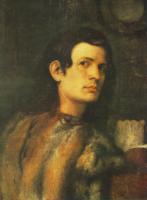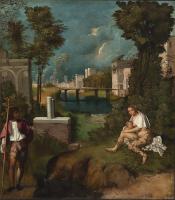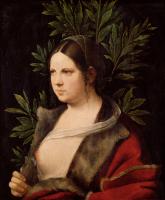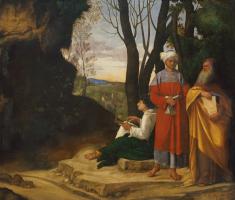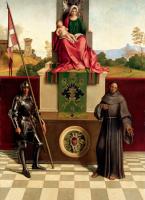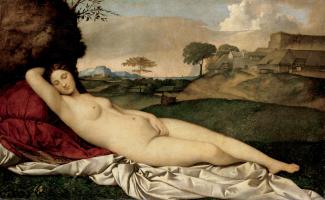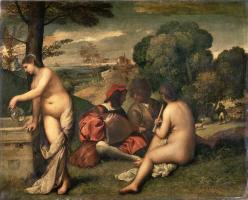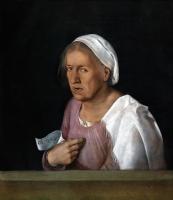Giorgione
Giorgione, born in Castelfranco, some twenty-five miles from Venice, is one of Europe’s greatest painters, yet practically nothing is known about him. It is thought that he worked with or was apprenticed to Giovanni Bellini in Venice, that in Bellini’s studio he met the young Titian, and that Titian in his turn became Giorgione’s pupil.
He died of the plague in his early thirties, and some of his paintings may have been finished by other artists after his death. This has added to the considerable problem of deciding which works are entirely authentic and which are not.
As a result of his remarkable talent, and the fact that information about his life was invented because so little was known, a legend has grown up around him in which he has become a mysterious and almost mythical figure.
Portraits, religious scenes and landscapes were the themes of Giorgione’s small oil paintings, and he was the first artist in Venice to produce work for collectors rather than for churches or public buildings. Like The Tempest , many of his pictures do not represent a real or even mythological scene in the way that most paintings had done in the past. Giorgione was ahead of his time in that his work was created to express a mood or an idea, much as modern art does today, and this had a profound effect on his Ventian contemporaries and the painters who followed him.
 The Tempest is one of the very few paintings — about thirteen in all
— that have always unanimously been attributed to Giorgione, but its
subject has been disputed for over four centuries. X-rays have revealed that
Giorgione first painted another female nude where the man now is, which
indicates that he had no intention of illustrating a particular event, but was
allowing his imagination entirely to guide him.
The Tempest is one of the very few paintings — about thirteen in all
— that have always unanimously been attributed to Giorgione, but its
subject has been disputed for over four centuries. X-rays have revealed that
Giorgione first painted another female nude where the man now is, which
indicates that he had no intention of illustrating a particular event, but was
allowing his imagination entirely to guide him.
The scene is lit by the strange golden light of an approaching storm, and a streak of lightning pierces the heavy thunderclouds. On a grassy bank a plump young woman, naked but for a length of white cloth draped around her shoulders, cradles a baby to her breast, and a shepherd passing by stops to look at them from the water’s edge. The overwhelming, elemental force of Nature, and the part man plays in the cycle of life are implied by the storm and the figures in the landscape, and evidence of man’s creation of the civilized world is provided by the buildings along the river bank. In the distance are the dome of a church and the sunlit walls of battlemented palaces (on the roof of one a stork or heron is outlined against the sky). Behind the young man are the ruins of ancient buildings overgrown with trees, indicating perpetual change and the passing of time.
Giorgione has used intense colour and light to bind the composition together, and to pick out details of architecture, distant trees, the planks of the bridge, the shining foliage of bushes behind the two figures, and the beautiful naked flesh of the woman and her child. And he has reproduced superbly in this mysterious, emotional landscape the eerie light of a summer storm, and the electric tension it creates in the atmosphere.


